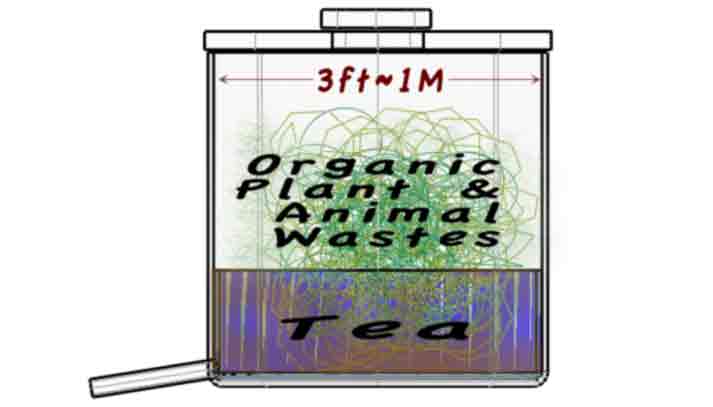
Here is a hypothetical plant fertilizer tea batching reactor- I believe this will make fertilizer abundantly and safely digest more waste sources. As the microbial process is expedited and microbial health is optimized. A critical size of compost mass was suggested in bio-dynamics study and also proves convenient for small scale use, where abundant output is desired. One meter or three feet is preferred as the smallest dimension-- To encourage and to maintain self heating and prolonged propagation of the compost mass. The wastes are simply dumped on top. Water (warm as possible), is periodically flooded through the mass. It displaces stationary air and could additionally add newly dissolved oxygen from oxygenated water. It is then drained as compost tea. The compost mass ages between the tea steeping- flooding. The draining draws in fresh air. So that continual use provides aerobic composting.

I have studied the art of composting in varied circumstances. Cooler weather composting demands warmth-- I decided to invest a lot of effort to make my fertilizing efforts more productive and more self sufficient. Preserving the ground heat throughout winter is made possible with ground cover insulation. Providing charcoal heating from combustible yard wastes allows considerable fertilizer production throughout cold weather. Compost-tea production, during extremely cold, far below freezing, will eventually be studied. Already, the changing seasons seem to suggest varied changes of routines. I am finding new insights while i use this installation.
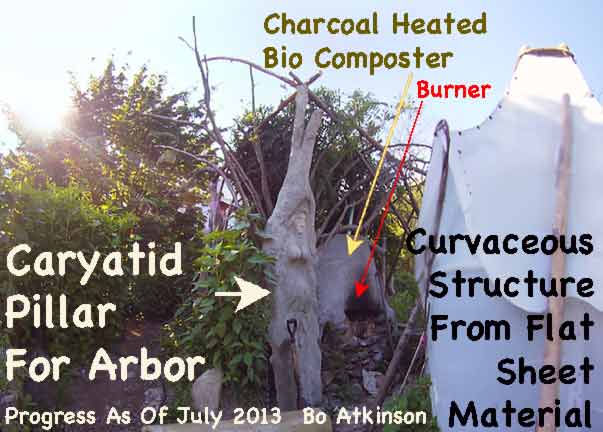
My work in the photos roughly follows the drawings below. The drawings should suggest use of ferrocement for construction. As this material fits all the needs. It is cost efficient and is buildable at reasonable cost. Where the user insists on the ability to produce abundant, high quality fertilizer for gardening. A fire proof vat of this size is expensive in corrosion proof metal, (about one meter or 3ft in diameter and height). So customized construction is recommended. Acquiring the skills or hiring builders is expected. I will detail more on this in due course and welcome discussion about this. I cannot (single handedly) set up a forum because my offerings are too complexly integrated.
Therefore write to me.![]()
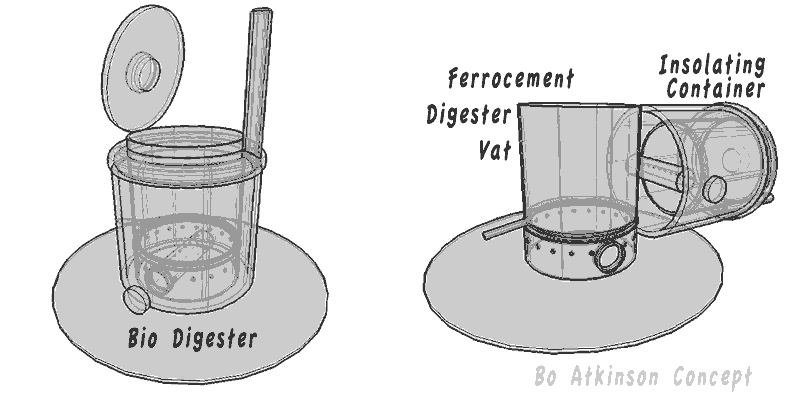
The charcoal burner can be made with a piece of stove pipe and insulation stuffed in the ends. "Charcoal burning" is achieved with very slow burning and with continued stuffing of sticks... Trimmings from garden or brush reach the charcoal stage quickly during full flames, needing the tightly fitting closure, for the very slow burning. Shallow water filling will further slow the heating, which is desirable. Periods of continuous trickles of water through, even while heating is expected to stimulate, continuous composting. The heat output is very small and therefore gentle. The exhaust is forced along the vat walls, in a narrow space. The narrow spacing distributes the exhaust all around the vat.

The heat is made to distribute around the vat somewhat evenly. Just enough heat to raise the compost to a rapid decomposition stage. I don't use thermometers or precision. I simply note that the tea-water-tea feels 'warm' and that heat is spreading throughout the vat. Warm vapors diffuse the un- submerged compost mass. The digester will tend to maintain heat, once started, due to microbial decomposition. The tea can steep for a day or two-- Due to the oxygen consumption by aerobic microbes-- Aerobic microbes are here preferred, because these are the healthiest microbes for human contact. Web search "Anaerobic microbes" + disease, also search "aerobic microbes" + health.... To see the important distinction, which justifies the investment of labor and costs. My approach has been to devise homemade approaches which can optimize home gardening. I believe that excellent, aerobic inoculants can be found in existing soils of abundant gardens and especially healthy landscapes. One can learn to discern these. Or, alternatively buy products and services from trusted sources.
2012 Summer Progress: Ferro Cement will cover exterior:
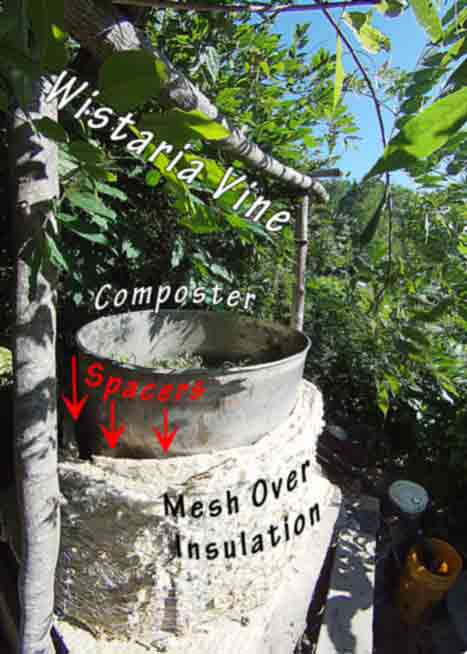
Early Summer, a footing is mostly dry laid but with some globs of concrete to stabilize, (while economizing... We have an over abundance of these stones.)

Picture Below: This happens to be a salvaged, stainless steel *vat, from a junk yard. I paid approximately $30 for it in the 1970s. It saves me much building time. I still claim that a cementitious vat can be built.
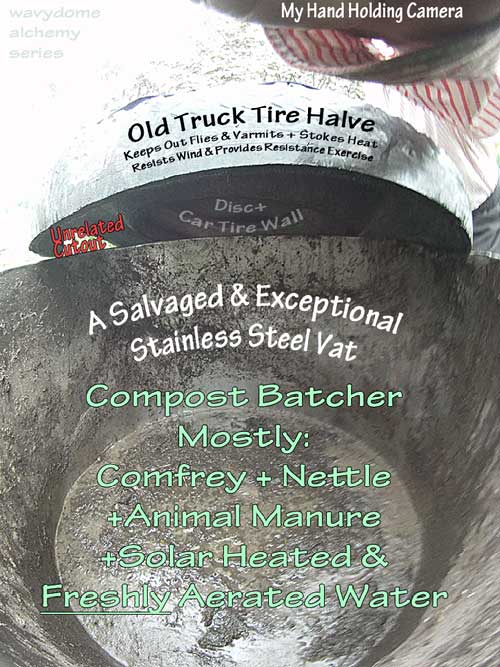
I have adopted just several aspects of Bio Dynamics, from reading Agriculture, by Rudolf Steiner. I have applied some of the principles for 40 years and appreciate the traditions as i assumed Steiner had credited them. I therefore strive for maximum oxygen in my composting reactor: The compost reactor bottom is first layered with a shallow pile of twigs. Spread the pile flat into several compact layers. This will eventually let liquid drain down from decomposing masses above. Draining liquid tea from the mass above will draw in air with oxygen. This cycling of wet-steeping and draining action sustains healthy, breathing composting. Regular tea batching removes sediments which might otherwise clog the system. The ability to apply gentle heating accelerates compost action and destroys the unwanted, unhealthy, anaerobic, salmonella bacteria. So that risk of contaminating the garden produce is largely reduced. It is not necessary to place unfinished compost and/or manure near to garden produce, nor incur the risk. Fully composted tea will not promote harmful microorganisms nor attract many flies. I have wondered if Steiner's references to earlier farming practices had benefited from the Gnostics and concepts of alchemy.
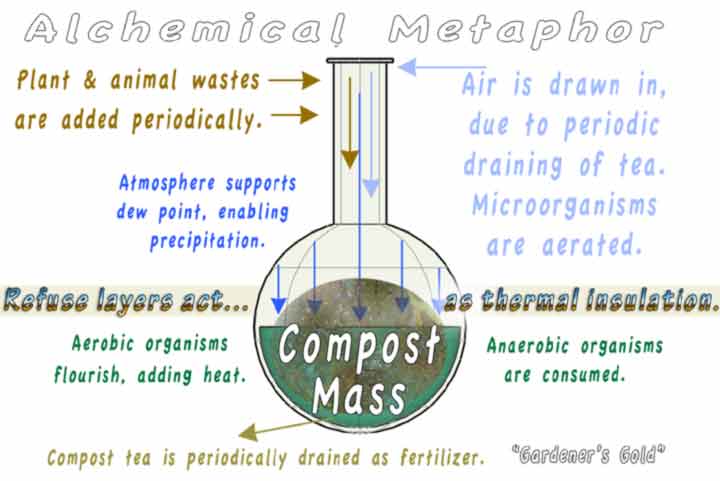
In a sense, compost batching is alchemical. A purportedly ancient alchemy text: BookOfAquarius.pdf, was suggested by famous "authorities on the hermetic and alchemical traditions" (Google lists 137,000 search results at this 2012 update-writing.) An updated version of this text was promised on line. The first version seemed repetitive and emphasized histories of persons producing a philosopher's stone from human urine. The first version, was purportedly compiled from ancient writings. I found no verifiable evidence concerning the promised "philosopher's stone", but i was interested by the apparent similarities to composting animal and plant wastes, in a reactor (or flask). The temperature management is much easier in composting wastes. Gradual additions and gradual conversion make nutrients for plants. This natural, compost-oriented-transformation is an alchemy which produces a gardener's gold.
Back to more detailing of my preferences in composting methods:
Above the bottom twigs, add an equal layer of soft leafy herbs or soft organic debris. Preferably selective weed-herbs had on hand. Focus on soft leafy portions. Burdock is another good, soft and leafy weed. Lawn mown material is appropriate otherwise-- It can add good heat by itself, if if is fresh, lush & green, (typical of rainy climates or seasons, primarily). If none of these are available, then use what is there, close to hand. Alchemical style is progressive and successional, from season to season-- Find what is available at hand, as one goes along.
Most powerful, is (a) layer(s) of manure. Better are several kinds of manure, new, old wet, dry and of differing animals. 'Rich' kitchen wastes are good. Also spoiled foods are good-- Herewith foods are deprived from unwanted vermin. This is actually very important, as abundant gardens will attract vermin. So that the gardener has to maintain appropriate balances of life forms. Absolutely avoid any disinfecting cleansers or poisons. Sprinkle on lightly, some of your best available loam. Weeds with roots intact are a desirable desirable example here-- To be rid of them and not to add too much root soil, intact. Soils interspersed with plant and animal wastes. Soils do provide and can propagate desirable strains of micro organisms. Next repeat layers of greens and manures, as might be had. Add these over time, as the pile will compress downwards. It is good to continue additions. The variety of additions will continually maintain 'open' channels for aeration and tricking flows of moving-water. Keep the process actively in motion. Keep teas brewing additional garden fertilizer and then spread the fertilizer. Reduce rot accumulations near to growing plants, because rot, can or propagate attracts pests. Optimizing conditions will increase yields. This is work which can become an exercise routine. Personally, i integrated simultaneous multi-varied studies, with these tasks. Mastering a skill of mixing physical-work with active mental processing of multi-varied studies or work thoughts.
Variance to above can help: Add to above mix, varieties of chosen wastes. There are multiple good reasons to choose particular wastes. I will list a few. Plant disease, mold or mildew should be 'quarantined' from garden. I believe the best method is to use hot-to-touch composting. Especially to finish the process with aerobic Composting, before returning the tea to the garden. This is why i endeavor under great duress to develop and experiment with this system. If mildew or mold attack the garden: I prefer, first to singe with fire, then hot-compost the singed material.
Dead creatures which might turn up are best buried away from garden or well heated through thorough composting. Small inputs of poisoned rats or mice are OK if the poison had been the common anti-freeze type (warfarin type). Otherwise, one could refer to toxicology data, to insure that the substance is bio degradable. I happen to avoid toxic chemical sand even pharma products of any kind. As these are proving to not be non-bio-degradable. Reports are common of pharma products polluting the environment, seemly not bio degrading... Proportionately small amounts of meat scraps, can be good-- Bone adds valuable bio-phosphorus-- Maintaining over 50% cellulose or plant material is key, in my opinion. Adding healthy, aerobic soil or recycling healthy tea on top, is also key. This will reduce the attraction of vermin and pests. Or protect one's own dog from bones-too-sharp-to-swallow. Avoids attracting scavenging predators. I have observed that almost all these listed kinds of materials become completely broken down over time-- Given adequate nitrogen-bearing wastes: Most notably animal wastes contain this bio-nitrogen. While some people detest the notion, i will only lightly mention, that human waste provides nitrogen or urea which is otherwise difficult to make up for. Unless one has animal wastes available. A truly harmonious world needs to use all wastes to a good benefit. I believe that pre industrial societies counted very much on human wastes to fertilize food produce-- Yet the higher-heating of compost is, in my estimation vital to transforming the undesirable constituents of human waste. considering the stresses of our current 'civilization', (potential disease, contaminations, etc).
Larger, weedy garden plots can be 'weeded' with large sheet covers. The heat accelerates composting, but....
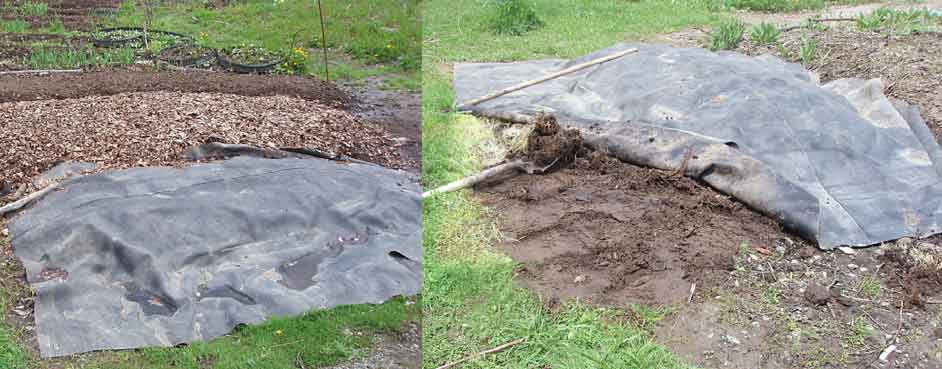
Rubber- roofing sheets resist wind best. This feature simplifies chores.
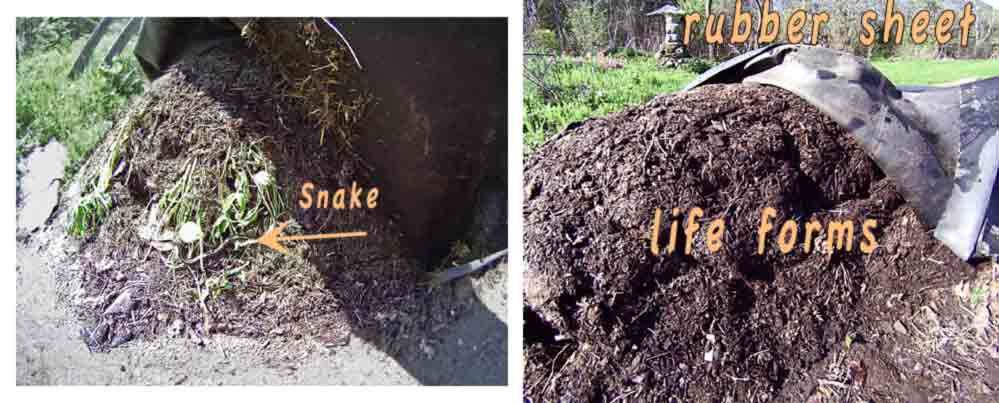
I use the layering method. Or simply assure there is a good mixture of soil and weed material. A good, balanced population or ecosystem of insects and small animals also improve the composting. However, dead- animal- content should be kept minimal here, to avoid attraction of rats. I wish there were ways to actually cooperate between all animals. As harmony of life forms seems to me the best hope for a better future.
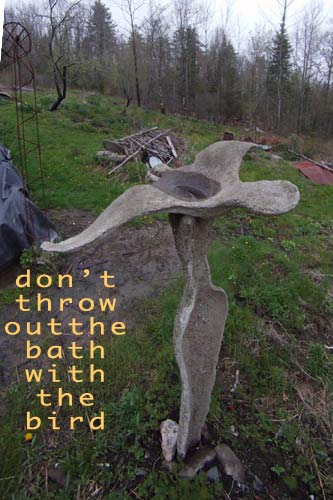
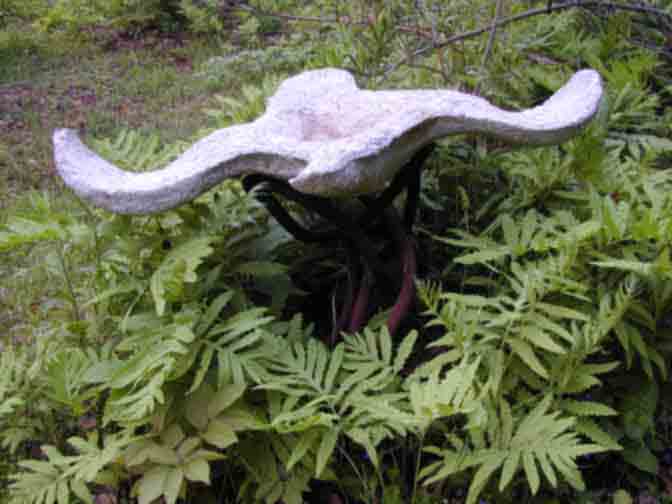
Safer garden spaces help attract wonderful wild birds, who will manage garden pests and provide bird songs. Chirps allegedly help plants prosper too. Proof of this must be lived in, rather than simply memorized from texts. Last but not least: Reduce the toxic build up of modern landfills which amass the worst combinations of artificiality. (Land fills deprive the earth of healthful-harmonious-interactions.) Be the change earth needs.
Well aerated, warm composting reduces odors. I decided to use surplus solar heated water to improve my compost tea. Doing this on sunny days all through the spring and early summer. Perennial shrubs should not be tea-fed, late in season. So that these shrubs can prepare for winter.
Batching should start, no later than late winter, but with just a little shallow water only. Plug or stop the draining. Ensure that water remains in bottom-- Then fire with gentle charcoal burning. Winter composting breaks down the collected surge wastes. Typically not leafy wastes at that time of year, except from greenhouse. Nevertheless, the summer accumulations of leaf stalks will still provide the needed carbon, to balance the animal wastes of high nitrogen content. Barely moist conditions are best. A small fire of brush or branch-debris can provide optimal compost pre-heating. Occasional heating only, can overcome frozen idleness, during colder weather. The ground-stored heat from firing, can persist a surprising length of time-- Along with the carbon- nitrogen reaction of composting wastes.
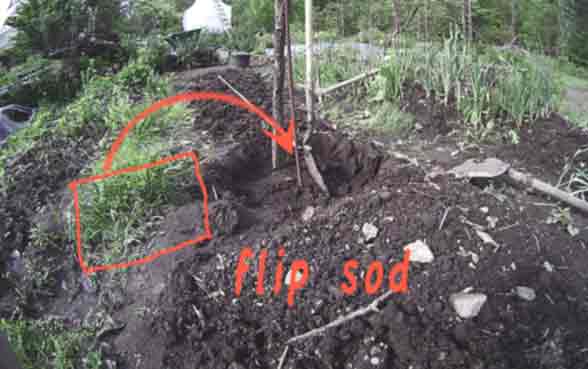
With the abundant spring growth here, flipping 'sod' (weeds) is a simpler practice. Admittedly, i am a bit lazy or late with gardening chores.
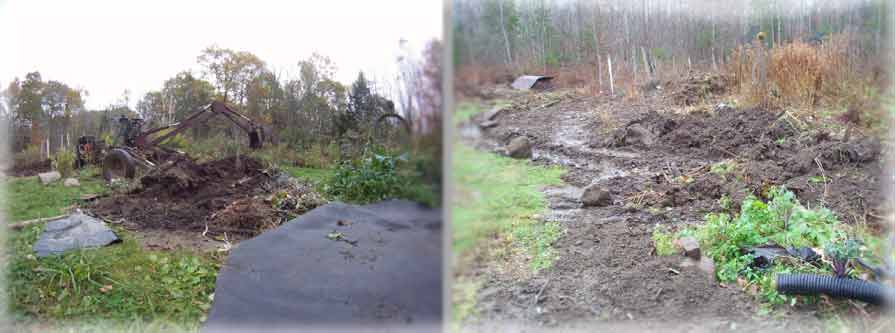
Land sculpting should keep top soil on top. Large weeds and shrubs do good when buried underneath topsoil. Sub soils, lacking in eco systems, will not decompose thicker twigs, or else require many years, (in cool climates). Chickens are great helpers with landsculpting, eating bugs adding small doses of nitrogen, diffused through gardens, off season, not during produce growing.
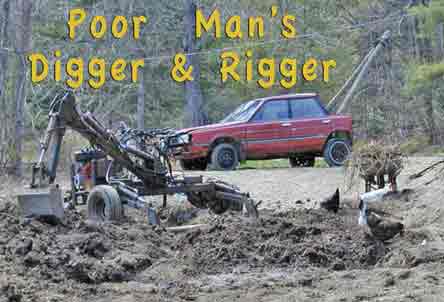
This page was started in 2012.
Years after starting this page, i have come across Viktor Schauberger's works(Sept 2013). I am adding his very interesting images and a link describing his concept of an egg-shaped compost heap. His book titled Living Energies is avail ale as a free PDF download. Search for this title online, as there are many sites and availability might change over time. This book by Callum Coats who sacrificed a career in architecture, to instead compile and publish the works of Schauberger. His books are full of high quality concepts across multiple subjects. These are integrated into comprehensive texts.

This egg concept for composting with a pre-existing, large, live tree inside intrigues me. I am a bit caught up with my methods described above, but would love to try something like this if life were less crowded with commitments. One question coming to mind is: Should the effort begin by exposing the large roots at the tree's base? This would seem destructive. One possible interpretation of the egg region is that the compost above ground level merely associates with the base of the tree but does not require initial exposure of the root base. Also noted in the book is a partial similarity of the egg shape with the ancient amphorae which were the ancient design for storage and shipping containers or large clay vessels. Oils and wines were traded in these containers. Schauberger also applies this egg shape to other of his inventions
My pictorial site index is here.
Write to me:
![]()
Note: My 100s of pages on this website, http://harmoniouspalette.com, are placed in the The content on this website, http://harmoniouspalette.com, is placed in the public domain only as a free exchange of ideas and as a "hard studied wish to serve life". The author assumes no responsibility for the improper use of the concepts in these web pages. All relevant laws of life and local codes should be verified and observed before any building or experimentation proceeds. discussion is welcome, please write. Bo Atkinson and are furnished "as is" and "open source". My creativity is posted as a free exchange of ideas and as my "service to others". Caution: The author assumes no responsibility for the improper use or improper misuse of the concepts in these web pages. All relevant laws of life and local codes should be verified and observed before any building or experimentation proceeds. Donations to me would be welcome, for me to continue or to up step the progress of these works. Cooperation might be possible as well, please write. Bo Atkinson
*Admittedly, finding a suitable vat is either expensive or it takes a lot of junk yard exploration. Sadly the tort-lawyers have closed down access to most junk yards nowadays. If not for this prized vat, i would build a cementitious vat, in place... (Using ferrocement or the latest cementitious-reinforcement to go with, is basalt-fiber-reinforcement....yet another subject.) Rudolph Steiner taught from the old lore: That something a meter or 3 feet dimension promotes optimal self-heat-building, microbial colonization, etheric-elemental combinations. I adopted this premise, somewhat associating it with Gnostic and alchemical tradition. The modern chemist might differ, so be it.
It find it sad to note that resourceful junk yards are being 'outlawed'. I also regret to observe gradual outlawing of self-resourceful living. For example, GMO tactics threaten the practice of seed saving and free organic gardening. I feel that the GMO marketing practices are a repulsive form of collectivism-- Where a collectivist human controller gradually attempts to outlaw country life styles of individualism-- Just as the individualist Gnostics were murdered by cults who plundered Europe, demanding centralized religious conformity. I make my efforts to help preserve self sufficient aspects of living. I oppose collectivism in any guise. I oppose the various,controlled, mass media promotions of collectivism.